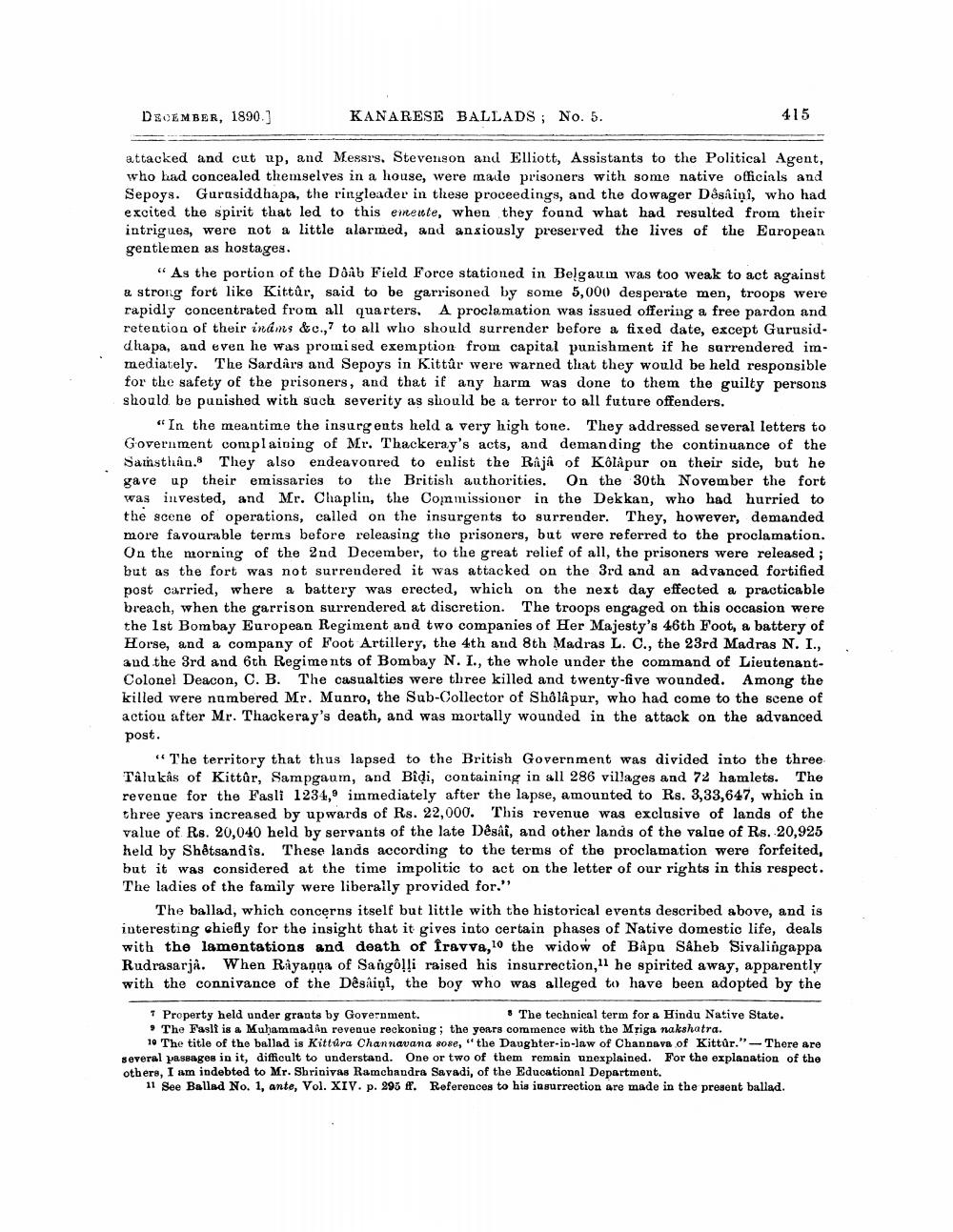________________
DECEMBER, 1890.)
KANARESE BALLADS; No. 5.
415
attacked and cut up, and Messrs. Stevenson and Elliott, Assistants to the Political Agent, who had concealed themselves in a house, were made prisoners with some native officials and Sepoys. Gurasiddhapa, the ringleader in these proceedings, and the dowager Desaiņi, who had excited the spirit that led to this emeute, when they found what had resulted from their intrigues, were not a little alarmed, and anxiously preserved the lives of the Earopean gentlemen as hostages.
“As the portion of the Doub Field Force stationed in Belgaum was too weak to act against a strong fort like Kittûr, said to be garrisoned by some 5,000 desperate men, troops were rapidly concentrated from all quarters, A proclamation was issued offering a free pardon and retention of their indms &c.,7 to all who should surrender before a fixed date, except Gurusiddhapa, and even he was promised exemption from capital punishment if he surrendered immediately. The Sardars and Sepoys in Kittür were warned that they would be held responsible for the safety of the prisoners, and that if any harm was done to them the guilty persons should be punished with such severity as should be a terror to all future offenders.
"In the meantime the insurgents held a very high tone. They addressed several letters to Government complaining of Mr. Thackeray's acts, and demanding the continuance of the Samsthân. They also endeavoured to enlist the Raja of Kolapur on their side, but he gave up their emissaries to the British authorities. On the 30th November the fort was invested, and Mr. Chaplin, the Commissioner in the Dekkan, who had hurried to the scene of operations, called on the insurgents to surrender. They, however, demanded more favourable terms before releasing the prisoners, but were referred to the proclamation. On the morning of the 2nd December, to the great relief of all, the prisoners were released ; but as the fort was not surrendered it was attacked on the 3rd and an advanced fortified post carried, where a battery was erected, which on the next day effected a practicable breach, when the garrison surrendered at discretion. The troops engaged on this occasion were the 1st Bombay European Regiment and two companies of Her Majesty's 46th Foot, a battery of Horse, and a company of Foot Artillery, the 4th and 8th Madras L. C., the 23rd Madras N. I., and the 3rd and 6th Regiments of Bombay N. I., the whole under the command of LieutenantColonel Deacon, C. B. The casualties were three killed and twenty-five wounded. Among the killed were numbered Mr. Munro, the Sub-Collector of Shâlâpur, who had come to the scene of actiou after Mr. Thackeray's death, and was mortally wounded in the attack on the advanced post.
"The territory that thus lapsed to the British Government was divided into the three Talukås of Kittûr, Sampgaum, and Bidi, containing in all 286 villages and 72 hamlets. The revenge for the Fasli 1234,9 immediately after the lapse, amounted to Rs. 3,33,647, which in three years increased by upwards of Rs. 22,000. This revenue was exclusive of lands of the value of Rs. 20,040 held by servants of the late Désál, and other lands of the value of Rs. 20,925 held by Shetsandis. These lands according to the terms of the proclamation were forfeited, but it was considered at the time impolitic to act on the letter of our rights in this respect. The ladies of the family were liberally provided for."
The ballad, which concerns itself but little with the historical events described above, and is interesting chiefly for the insight that it gives into certain phases of Native domestic life, deals with the lamentations and death of Iravva, to the widow of Bapa Saheb Sivalingappa Rudrasarja. When Rayanna of Sangolli raised his insurrection," he spirited away, apparently with the connivance of the Desaiņi, the boy who was alleged to have been adopted by the
* Property held under grants by Government.
• The technical term for a Hindu Native State. The Faslt is a MuhammadAn revenue reckoning; the years commence with the Mriga nakshatra.
10 The title of the ballad is Kittara Channavana sose, "the Daughter-in-law of Channava of Kittur." -There are several passages in it, difficult to understand. One or two of them remain unexplained. For the explanation of the others, I am indebted to Mr. Shrinivas Ramchandra Savadi, of the Educational Department.
11 See Ballad No. 1, ante, Vol. XIV. p. 295 ff. References to his insurrection are made in the present ballad.




